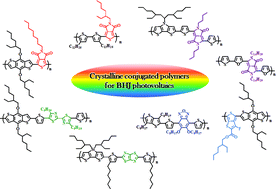Crystalline donor–acceptor conjugated polymers for bulk heterojunction photovoltaics
Abstract
Molecular engineering of

* Corresponding authors
a
National Chiao Tung University, Materials Science and Engineering, Hsinchu, Taiwan
E-mail:
khwei@mail.nctu.edu.tw
b Anna University, MIT Campus, Department of Chemistry, Chennai, India
Molecular engineering of

 Please wait while we load your content...
Something went wrong. Try again?
Please wait while we load your content...
Something went wrong. Try again?
J. Jiang, M. Yuan, K. Dinakaran, A. Hariharan and K. Wei, J. Mater. Chem. A, 2013, 1, 4415 DOI: 10.1039/C2TA00965J
To request permission to reproduce material from this article, please go to the Copyright Clearance Center request page.
If you are an author contributing to an RSC publication, you do not need to request permission provided correct acknowledgement is given.
If you are the author of this article, you do not need to request permission to reproduce figures and diagrams provided correct acknowledgement is given. If you want to reproduce the whole article in a third-party publication (excluding your thesis/dissertation for which permission is not required) please go to the Copyright Clearance Center request page.
Read more about how to correctly acknowledge RSC content.
 Fetching data from CrossRef.
Fetching data from CrossRef.
This may take some time to load.
Loading related content
